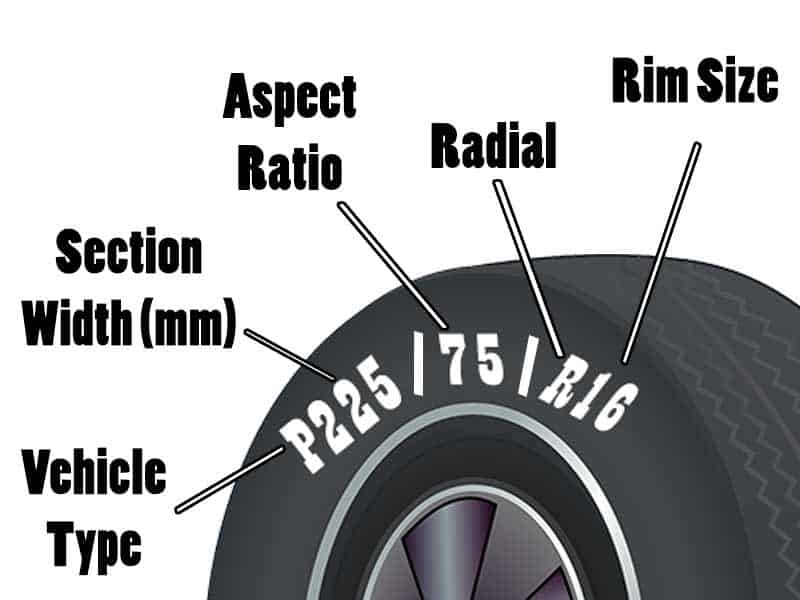You must know proper size of tire for your car after you’ve decided it’s time to buy new ones. Typically, the owner’s manual for your automobile may be found within the doorjamb.
It will be beneficial for you to understand tire sizing to guarantee that your present tire or any replacement tires you may be considering meet the criteria for your car.

The series of numbers and letters on each tire may have escaped your notice in the past, but they contain a wealth of knowledge.
It’s simple to understand what all the letters and numbers on the sidewall of your tire indicate with a little explanation.
The statistics serve as benchmarks for tire performance, kind, and size.
The letters and numbers on the sidewall of the tire include the Vehicle type / Tire type, width, Aspect Ratio, Construction, Rim Diameter, Load Index, Speed Rating.
Table of Contents
Tire Type
The word “P-Metric” appears at the beginning of the letters and numbers which means tires built to certain specifications in the United States and meant for Passenger cars.
If tire size begins with no letters, it is said to be Euro metric.
The load capabilities of P-Metric and Euro-Metric tires are different from each other. Most of the cars, light pickups having half ton or low weight comes with the tires that are P-Metric or Euro-Metric.
Light truck tires are identified by the initials “LT,” either at the start or end of the tire size. Some light vehicles come from the factory with “LT” type tires.
In comparison to passenger tires, these tires often need greater inflation pressures. Other tire kinds that fit into the category include Temporary Spares, which begin with the letter “T”.
A size designated as “special trailer” or beginning with “ST” is solely intended for trailers.
No matter if you’re looking at a P-Metric, Euro-Metric or any other type the size numbers, all indicate the same thing.
Tire Width
Tire width is measured in millimeters from one sidewall of the tire to the other one.
The first three numbers are the width in millimeters.
For example, in the P215/65 R15, the width of tire is 215 millimeters.
Aspect Ratio
Aspect Ratio is the proportion of the tire’s cross-height sections to its width.
The aspect ratio can be found in tire sizes as the two-digit number following the slash.
The aspect ratios are generally shown in percentages. In the P215/65 R15, the aspect ratio is 65 which means the height of tire is 65 % of its width.
Although tires with lower aspect ratios, like the 60 series, often perform better for vehicle handling than tires with higher aspect ratios, like the 75 series, a common trade-off is ride roughness.
Construction
The letter after the aspect ratio specifies the type of construction of the tire.
The types of construction are:
- R – Radial
- B & D – Diagonal & Bios ply
Radial tires are the conventional used tires. In a radial construction, the inner ply cords are arranged from one bead to the next in a radial pattern that is virtually perpendicular to the way of rotation.
Rim Diameter
Next to the construction type, the number indicate the diameter of the rim in inches.
It is the size of rim upon which the tire fits. The P215/65 R15 tire is designed to fit a 15″ diameter wheel.
Load Index
Tire’s load index indicates maximum weight, in pounds, the tire can support when completely inflated: P225/70R16 91S.
We refer to it as the load “index” since the number, at least by itself, does not specify the specific number of pounds the tire can support.
Speed Rating
The speed rating, denoted by a letter and the last number in a sequence, is P225/70R16 91S. For instance, tire having a speed rating of “S” is capable of 112 mph, while the tire with speed rating of “R” is capable of 106 mph.
Uniform Tire Quality Grading
The UTQG (Uniform Tire Quality Grading) is located on the sidewall of the tire, and it communicates information about three things which are namely treadwear, temperature and, traction of the tire.
Furthermore, it consists of 3 digits and 2 alphabets, 3 digits are for treadwear rating of the tire, one alphabet is for temperature rating and the last one is for traction rating.
Treadwear
Treadwear rating range goes from 100 to 1000, for instance 100 being the standard value, it gives the minimum amount of wear that a tire can have, and it is expected to last the least.
In comparison to that, a tire with a 300 treadwear rating is expected to last three times longer and give three times the millage in similar conditions.
Temperature
When tire spins on a road, it creates a lot of friction due to the tires, this fiction increases the temperature of tire.
Temperature rating is categorized into three grades A, B and C.
Tires with the grade A can withstand temperatures at speeds above 115 mph or 185 kph.
- The tires with grade B can endure temperatures at 100 to 115 mph or 160 to 185 kph.
- Grade C could tolerate temperatures at 85 to 100 mph or 129 to 160 kph.
Traction Rating
Traction grading is measured in terms of ability of the tire to stop (break) in a straight pathway when the conditions of the road are wet, however the dry road are not considered.
Traction Rating is graded into four classes, AA, A, B and C.
Grade AA has the highest traction rating while the Grade C has lowest traction rating.
Conclusion
Information about tire size is very important for buying new tires.
Thus, the letters and numbers written on the sidewall of the tire is of much importance.
Understanding the tire type, Tire width, Aspect Ratio, Construction type, Diameter of Rim, Local Index, Speed Rating & UTQG helps in buying tires.